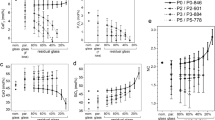Abstract
A bioactive glass containing (in wt%) SiO2 48, P2O5 9.5, Na2O 20 and CaO 22.5 was transformed into a glass-ceramic through a heat treatment. The apatite formation on the surface of this glass-ceramic was examined in a simulated physiological solution. The data from X-ray diffraction, infrared reflection spectroscopy, scanning electron microscopy together with energy-dispersive X-ray analysis and composition imaging of backscattered electrons showed that the formation of the surface apatite layer depends on the relative amount of residual glassy phase in the glass-ceramic. The apatite layer was found to formin vitro on its surface if the glass-ceramic contained a residual glassy phase in a relative proportion more than a limiting volume. It lay on a layer rich in silica. However, only, a silica-rich layer was developed within the surface region of the glass-ceramic during the interaction with solution if the glass was almost completely crystallized. It is proposed that the apatite formation on the surface of the glass-ceramic is mainly caused by its residual glass. The residual glass facilitating apatite formation is considered to provide a negatively charged surface developed during its corrosion in the surrounding solution. The negatively charged surface attracts calcium ions and creates a solution within the glass — solution interface that is highly supersaturated with respect to hydroxyapatite. This leads to the formation of apatite on the surface of the glass-ceramic.
Similar content being viewed by others
References
L. L. HENCH, R. J. M. SPLINTER, W. C. ALLEN and T. K. GREENLEE,J. Biomed. Mater. Res. Symp. 2 (1971) 117.
S. F. HULBERT, in “Handbook of bioactive ceramics”, Vol. 1, edited by T. Yamamuro, L. L. Hench and J. Wilson (CRC Press, Boca Raton, Florida, 1990) p. 3.
L. L. HENCH,J. Amer. Ceram. Soc. 74 (1991) 1487.
T. KOKUBO,Biomaterials 12 (1991) 155.
M. OGINO and L. L. HENCH,J. Non-Cryst. Solids 38–39 (1980) 673.
L. L. HENCH,Ann. NY Acad. Sci. 523 (1988) 54.
K. H. KARLSSON, K. FRÖBERG and T. RINBOM,J. Non-Cryst. Solids 112 (1989) 69.
T. KOKUBO, ibid.120 (1990) 138.
P. LI and F. ZHANG, ibid.119 (1990) 112.
Idem, in “C-MRS International 90: polymer and biomaterials”, edited by H. Feng, Y. Han and L. Huang (Elsevier, Amsterdam 1991), p. 459.
L. L. HENCH, in “Handbook of bioactive ceramics”, Vol. 1, edited by T. Yamamuro, L. L. Hench and J. Wilson (CRC Press, Boca Raton, Florida 1990) p. 7.
P. LI and F. ZHANG, in “Ceramic microstructure 86”, edited by J. A. Pask (Plenum Press, New York, 1987) p. 127.
Idem, Glass Enamel 16 (6) (1988) 6.
C. A. M. SISKNS and J. M. STEVELS,J. Non-Cryst. Solids 19 (1975) 125.
L. C. BELL, A. M. POSNER and J. P. QUIRK,J. Colloid Interf. Sci. 42 (1973) 250.
J. CHRISTOFFERSEN and M. R. CHRISTOFFERSEN,J. Cryst. Growth 57 (1982) 21.
M. MATSUMOTO, T. MIYAKE, H. NOSHI, M. KAMBARA and K. KONISHI,J. Colloid. Interface. Sci. 40 (1989) 77.
T. KOKUBO, T. HAYASHI, S. SAKKA, T. KITSUGI, T. YAMAMURO, M. TAKAGI and T. SHIBUGA, in “Ceramics in clinical Applications”, edited by P. Vincenzini (Elesvier, Amsterdam 1987) p. 175.
U. GROSS and V. STRUNZ,J. Biomed. Mater. Res. 19 (1985) 251.
U. GROSS, J. BRANDES, V. STRUNZ, I. BAB and J. SELA, ibid.15 (1981) 291.
Author information
Authors and Affiliations
Rights and permissions
About this article
Cite this article
Li, P., Yang, Q., Zhang, F. et al. The effect of residual glassy phase in a bioactive glass-ceramic on the formation of its surface apatite layerin vitro . J Mater Sci: Mater Med 3, 452–456 (1992). https://doi.org/10.1007/BF00701242
Received:
Accepted:
Issue Date:
DOI: https://doi.org/10.1007/BF00701242




